You know how it is when someone tries to make a point about Canadian higher education using data from American universities? It’s annoying. Makes you want to (verbally) smack them upside the head. Canada and the US are different, you want to yell. Don’t assume the data are the same! But of course the problem is there usually isn’t any Canadian data, which is part of why these generalizations get started in the first place.
Well, one of the neat things about the AHCA-NCHA campus health survey I was talking about last week is that it is one of the few data collection instruments that is in use on both sides of the border. Same questions, administered at the same time to tens of thousands of students on both sides of the border. And, as I started to look at the data for 2016, I realized my “Canada is different” rant is – with respect to students and health at least – almost entirely wrong. Turns out Canadian and American students are about as alike as two peas in a pod. It’s kind of amazing, actually.
Let’s start with basic some basic demographic indicators, like height and weight. I think I would have assumed automatically that American students would be both taller and heavier than Canadian ones, but figure 1 shows you what I know.
Figure 1: Median Height (Inches) and Weight (Pounds), Canadian vs. US students.
Now, let’s move over to issues of mental health, one of the key topics of the survey. Again, we see essentially no difference between results on either side of the 49th parallel.
Figure 2: Within the last 12 months have you been diagnosed with/treated for…
What about that major student complaint, stress? The AHCA-NCHA survey asks students to rate the stress they’ve been under over the past 12 months. Again, the patterns in the two countries are more or less the same.
Figure 3: Within the last 12 months, rate the stress you have been under.
One interesting side-note here: students in both countries were asked about issues causing trauma or being “difficult to handle”. Financial matters were apparently more of an issue in Canada (40.4% saying yes) than in the US (33.7%). I will leave it to the reader to ponder how that result lines up with various claims about the effects of tuition fees.
At the extreme end of mental health issues, we have students who self-harm or attempt suicide. There was a bit of a difference on this one, but not much, with Canadian students slightly more likely to indicate that they had self-harmed or attempted suicide.
Figure 4: Attempts at Self-harm/suicide.
What about use of tobacco, alcohol and illicit substances? Canadian students are marginally more likely to drink and smoke, but apart from that the numbers look pretty much the same. The survey, amazingly, does not ask about use of opioids/painkillers, which if books like Sam Quinones’ Dreamland are to be believed have made major inroads among America’s young – I’d have been interested to see the data on that. It does have a bunch of other minor drugs – heroin, MDMA, etc, and none of them really register in either country.
Figure 5: Use of Cigarettes, Alcohol, Marijuana, Cocaine.
This post is getting a little graph-heavy, so let me just run through a bunch of topics where there’s essentially no difference between Canadians and Americans: frequency of sexual intercourse, number of sexual partners, use of most illegal drugs, use of seat belts, likelihood of being physically or sexually assaulted, rates of volunteering….in fact among the few places where you see significant differences between Canadian and American students is with respect to the kinds of physical ailments they report. Canadian students are significantly more likely to report having back pain, Americans more likely to report allergies and sinus problems.
Actually, the really big differences between the two countries were around housing and social life. In Canada, less than 2% of students reported being in a fraternity/sorority, compared to almost 10% in the United States. And as for housing, as you can see Americans are vastly more likely to live on-campus and vastly less-likely to live at home. On balance, that means they are incurring significantly higher costs to attend post-secondary education. Also, it probably means campus services are under a lot more pressure in the US than up here.
Figure 6: Student Living Arrangements.
A final point here is with respect to perceptions of campus safety. We all know the differences in rates of violent crimes in the two countries, so you’d expect a difference in perceptions of safety, right? Well, only a little bit, only at night and mostly- off-campus. Figure 7 shows perceptions of safety during the day and at night, on campus and in the community surrounding campus.
Figure 7: Perceptions of safety on campus and in surrounding community.
In conclusion: when it comes to students health and lifestyle, apart from housing there do not appear to many cross-border differences. We seem to be living in a genuinely continental student culture.

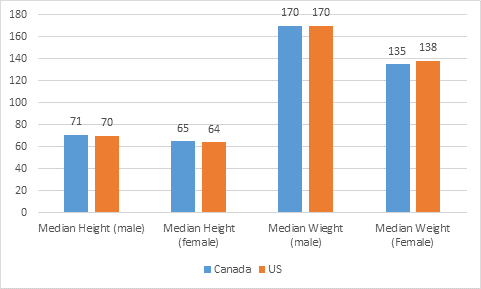

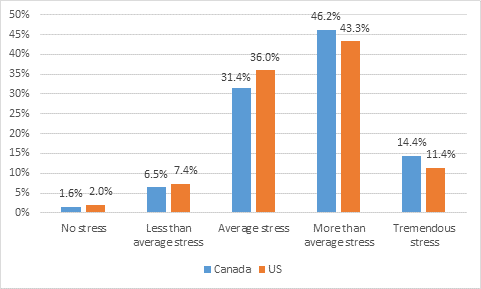
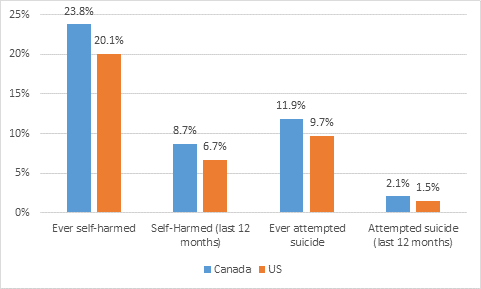
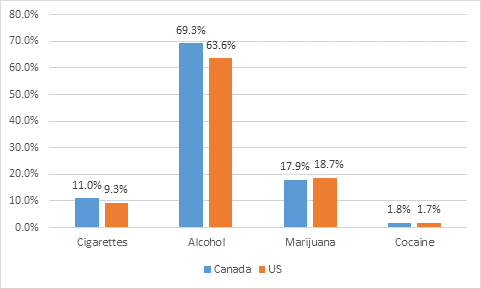
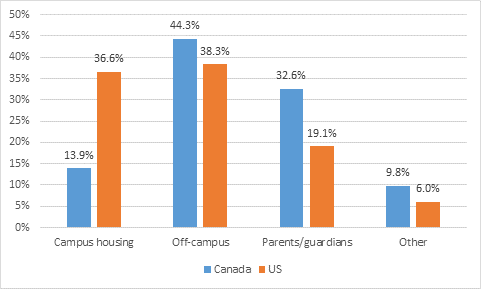
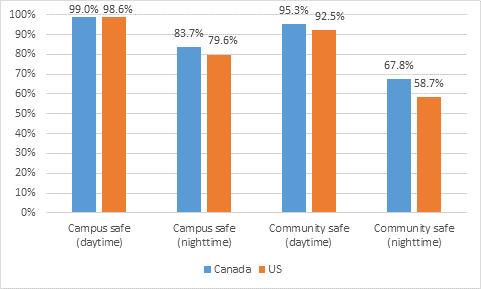
 Tweet this post
Tweet this post

Alex,
What you might not realize is that is very common for US schools to require students to live in on-campus housing…I went to graduate school in Ohio and the university I was studying at required all students to live in residence or an on campus Greek house for at least 2 years…this may explain the housing differences.
The difference in campus housing strikes me as quite significant.